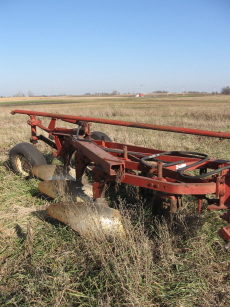Production
Sustainable Practices
Soils
Adam and Laura practice soil conservation by maintaining cover crops on steeper areas of the farm, adjusting field layouts to minimize soil erosion from rainfall, and using tillage practices that minimize soil compaction and disruption of soil structure. Although their tillage practices vary according to crop type, their standard approach is to prepare the ground in the spring by integrating the cover crop with a disc (Figure 37) and using a field digger (Figure 38) with a drag 1-2 weeks later. This sequence prepares the soil for planting, incorporates the cover crop, and works out the first flushes of spring weeds while still allowing some surface residue to remain.
| Adam and Laura prefer to dig and drag at least two times before planting or transplanting, if time and weather permit. They avoid overworking the soil in general and always avoid working it when it’s wet. Often, just field digging with a drag provides a clean and sufficiently even bed for seeding or transplanting. A chisel plow (Figure 39) is sometimes used in the fall for deep tillage, especially on fields where root crops will be planted the following year, but it still allows surface residues to remain. A moldboard plow (Figure 40) is used only to prepare ground that has been in hay for several years. | Educator’s Perspective: Resource Tip Equipment Although organic vegetable farmers use machinery to different degrees, it helps to understand what options are available. Excerpts from an educational video called Vegetable Farmers and Their Weed Control Machines are now available on the eOrganic You Tube channel and include many of the implements, such as chisel plows and basket weeders, in use at Loon Organics. |
Figure 37: A disc plow, or disc, uses one or more rows of concave discs to work the soil without turning it over completely. |
Figure 38: Loon Organics' field digger. |
Figure 39: A chisel plow accomplishes deep tillage without inverting the soil. |
 Figure 40: Loon Organics' three-bottom (or moldboard) plow, used for initial cultivation of fields to prepare for sowing or planting. |
Figure 41: Though tempting to use often because of its positive short-term effects, Laura and Adam are trying to minimize use of the rototiller because of its negative long-term consequences on soil health. |
When Laura and Adam started out, they used a rototiller (Figure 41) frequently because it made such nice seed beds. They quickly saw, however, that it had several negative effects: extreme compaction, destruction of organic matter and soil structure, hardpan below the surface, and increased noxious weed species such as quack grass and thistle. |
They are trying to get away from using a rototiller at all. They still use a walk-behind tiller to make raised beds in the hoop houses, and occasionally they will use the larger 6’ rototiller with a tractor to prepare outdoor seed beds when the digger/drag method isn’t effective. By rototilling only where needed to prepare for seed beds that must be very fine and even, such as for salad mix, they are minimizing disruption of soil structure.